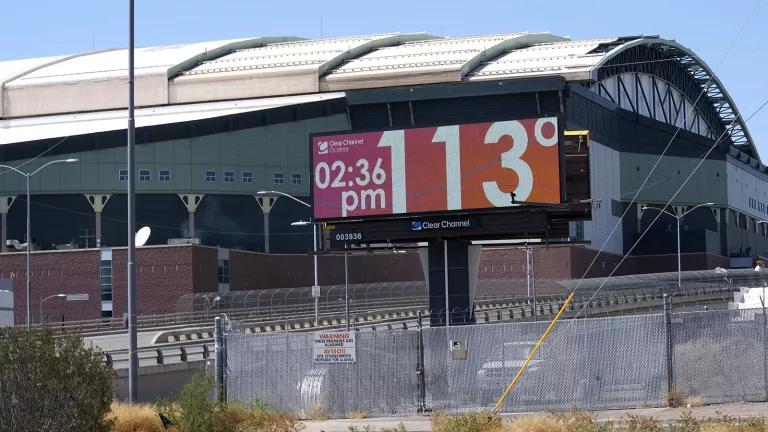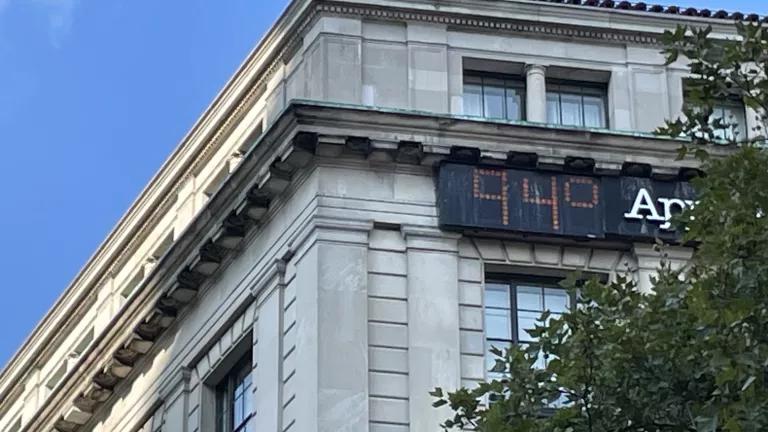Just last weekend, NRDC joined tens of thousands of New Yorkers in celebrating “City of Water Day,” an annual event that highlights the multitude of recreational, educational, and economic opportunities afforded by the rivers, bays, and open ocean waters that surround our island city.
Less than a week later, the big local story is “water water everywhere, but not a drop to play in” -- even as the city swelters through the worst heat wave of the summer and New Yorkers would love to cool off at their nearest beach or riverfront. As has been widely reported by now, a massive, ongoing sewage spill in Manhattan is fouling our local waterways and beaches.
But as bad as that is (see below for more on the spill), there’s an even more disturbing, inconvenient truth about sewage in our water: While NY Harbor is generally cleaner than it’s been in a century -- thanks to the very same Clean Water Act that a majority in the House of Representatives voted to gut last week -- the city still ROUTINELY dumps billions of gallons of raw sewage into local waterways every year when it rains.
Over 50 times a year, when we get as little as one-tenth of an inch of rain, our outdated sewer systems get overwhelmed and spew poop from some or all of 400+ locations along the shoreline, in all five boroughs.
To add insult to injury, unlike the current spill in the Hudson, there’s, not any public warning when those rain-induced spills happen -- even though the city is required by federal, state, and local law to notify the public of the location and occurrence of sewage overflows, and of the nature and duration of the resulting health risks. Other cities do a pretty decent job of that, and there’s no reason NYC can’t do the same.
Fortunately, there’s some good news too: As I’ve written previously, the city has tremendous opportunities to solve its perennial sewage overflow problem by literally greening the urban landscape. NYC can follow the lead of Philadelphia, which will invest at least $1.6 billion over the next 25 years to transform impervious spaces into natural sponges, using soils and plants to absorb rainwater before it ever reaches the sewers. New York has taken many important steps in that direction, though it still has a long way to go in developing a comprehensive, green approach to managing runoff. NRDC is continuing to work with city, state, and federal officials to advance that effort.
The Ongoing Spill from the North River Sewage Treatment Plant:
Let’s return our focus to the ongoing spill, which was triggered not by a rainstorm, but by a catastrophic fire on Wednesday at the North River sewage treatment plant, in West Harlem. The four-alarm blaze knocked out the huge pumps that ordinarily keep sewage moving through the facility. (Fortunately, it appears that no one was seriously injured in the fire.) The city’s Department of Environmental Protection is working hard to get the treatment plant back online as quickly as possible, but it remains out of commission as of this writing.
With the plant offline since Wednesday, well over 100 million gallons of untreated sewage (and still counting) have been dumped directly into the Hudson River, from overflow pipes all along the west side of Manhattan, as well as into the Harlem River.
But the sewage doesn’t stop there. The Hudson is the “River That Runs Both Ways,” as the Native Americans who were first to call its shorelines home named it. So the tides are bringing sewage north to the Hudson Valley, south to New York Harbor and Atlantic Ocean beaches, and even eastward into the East River and Long Island Sound. Not to mention the Jersey-ites on the west shore of the Hudson.
Initially, the city assured the public that there was no immediate risk to public beaches, while providing mixed messages, at best, about health hazards in waterways along rest of the city’s nearly 600 miles of shoreline. But the city ultimately clarified -- as it should have from the start -- that the massive sewage spill immediately puts the Hudson, Harlem, and East Rivers, which are typically safe for recreation, off limits to swimmers, kayakers and canoeists, and fishers. Westchester County officials issued a similar warning for their stretch of the Hudson, as did NJ for its side of the river.
With water-based recreation experiencing a renaissance in the city, that puts a damper on weekend plans for thousands of New Yorkers. I, for one, was planning to check out the Inwood Canoe Club’s weekly open house paddle on Sunday morning. But that’s going to have to wait for another day.
As the spill continues unabated, local beachgoers are now affected as well. On Thursday evening, the city announced public health advisories for two public beaches on the south shore of Staten Island, as well as two smaller private beaches in S.I. and Brooklyn. (Warning signs will be posted at those beaches discouraging people from going in the water, although the beaches have not been officially closed.) If the spill isn’t halted soon, it may force more health advisories or closures at area beaches, on the hottest weekend of the year.
For the most up-to-date information on the spill and related public health advisories, go to the NYC Health website at www.nyc.gov/health, the NYC Dept. of Environmental Protection’s site at www.nyc.gov/dep, or call 311. Our colleagues at Riverkeeper have been helping to inform the public about the risks, and have highlighted here why it’s important for government agencies to do pro-actively provide timely information about sewage pollution, both at beaches and rivers.
It’s well worth taking the official health advisories seriously. As NRDC recently highlighted in our annual “Testing the Waters” report on beach pollution, pathogens in sewage cause illnesses such as gastroenteritis, skin rashes, pinkeye, ear, nose and throat problems, respiratory infections, meningitis and hepatitis. Consequences are worse for children, the elderly, pregnant women, and anyone with a weakened immune system.
One final note: The city reports that it is adding chlorine to sewage at some of the overflow points, But, as we learned years ago, when the Bush Administration tried to legalize the temporary diversion of sewage around treatment plants, adding chlorine to otherwise untreated sewage is relatively ineffective at killing pathogens, and large doses of the chemical are harmful to aquatic life and create by-products that cause cancer in humans.
Let’s all hope the city gets this extraordinary spill under control VERY soon. Then it can get back to work on ending the “routine” sewage overflows that happen nearly every time it rains.




